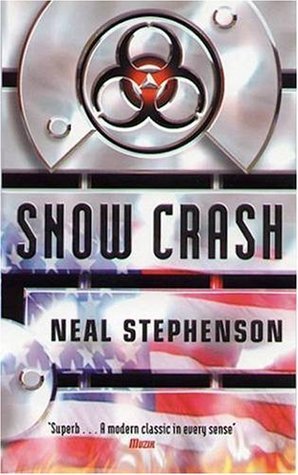This review includes spoilers, you've been forewarned.
(warning: not really a review, more of a thing to remind me of the book)
(warning: not really a review, more of a thing to remind me of the book)
Overall, a fairly cinematic story akin to the genre I'd expect The Matrix to fall into. If I'm completely honest, I did occasionally lose track of what was going on through the story (it took me a good few weeks to read it), but the story and two main characters managed to carry me along.
I also have to admit that it took me a little while to get past the corny named main character "Hiro Protagonist" and the overly macho techno all black, motorcycles and swords. Of course, Hiro is the world's best swordsman…obviously. Though when I just went with it, it was pretty good fun.
Neal Stephenson writing was extremely good at visualising a scene and the objects in the world the characters live in (in reading the acknowledgement I learnt that the book was intended as a graphic novel and I wonder if there was graphic work he was describing). All the same, it was very easy to read and see the world as we moved from reality, to the metaverse (virtual world), to vehicles and different landscapes.
There's a tonne of historical and religious background to the story too, most of which I understand to be based on real research (from our universe) and the depth of which was incredible.
The Snow Crash is (supposed to be) a virus that exists in both the digital world and the real world. The story creates (perhaps tenuous?) links between computer/digital ideas and pre-biblical times explaining that the story of Babel was the first instance of the virus, transmitted through verbal programming, affecting humankind.
The two other main-ish characters were Y.T (a young women/teenager who we follow in parallel with Hiro) and Raven. Y.T. is really fun, and perhaps more relatable since she's a little more "regular" (compared with Hiro) - just kitted out with lots of tricks in her suit.
Raven is the uber baddie, throwing glass spears, cutting through bulletproof suits and generally being invisible. He definitely plays the "main henchman" really well, and we even get to understand his motives which I love for a "proper" baddie.
Overall, I enjoyed the book, left a little confused about the motivation about some of the connections in the book (like what really motivates Y.T. to join forces with Hiro, or how Hiro was one of the first creators of the metaverse, yet he's somehow a promotor for his roommate's band…).
Sorry, not much of a review, more a prompt for my own memory in years to come!
10 Highlight(s)
the Deliverator's car unloads that power through gaping, gleaming, polished sphincters.
When you are wrestling for possession of a sword, the man with the handle always wins.
You can look like a gorilla or a dragon or a giant talking penis in the Metaverse. Spend five minutes walking down the Street and you will see all of these.
Software comes out of factories, and hackers are, to a greater or lesser extent, assembly-line workers. Worse yet, they may become managers who never get to write any code themselves.
Condense fact from the vapor of nuance.
The businessman turns out to have a lot of zanshin. Translating this concept into English is like translating "fuckface" into Nipponese, but it might translate into "emotional intensity" in football lingo.
Fluorescent lights and partitions with carpet glued to them. I prefer my carpet on the floor, thank you.
but he puts one together in several hours by recycling bits and pieces of old projects left behind in his computer. Which is how hackers usually do it.
He knows, now, that he has found his way into the boiler room of the entire Metaverse. But he has no idea what he's looking for.
I learned that the term 'avatar' has actually been in use for a number of years as part of a virtual reality system called Habitat, developed by F. Randall Farmer and Chip Morningstar. The system runs on Commodore 64 computers, and though it has all but died out in the U.S., is still popular in Japan.
